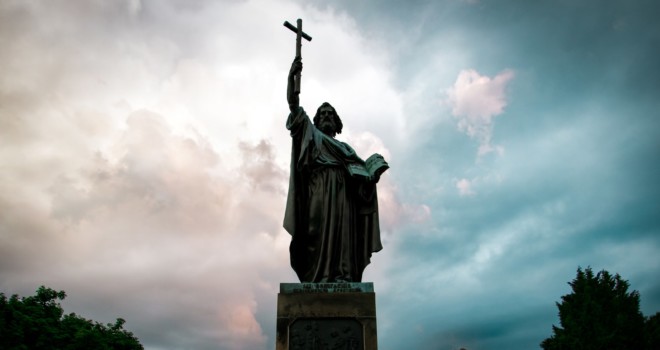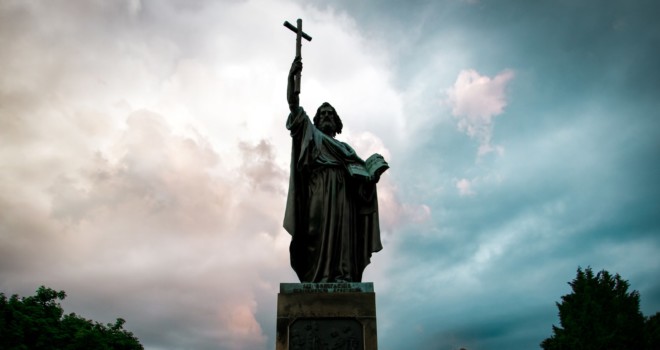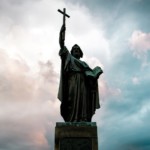Paths to Sainthood
In May 2007, Pope Benedict XVI issued the document Sanctorum Mater (Instruction for Conducting Diocesan or Eparchial Inquiries in the Causes of Saints) that denoted the three principal criteria for starting a sainthood cause: martyrdom, heroic virtue, and reputation for holiness. Popes may on their own initiative recognize someone as a saint in an “equivalent canonization” after a long-standing cultus (veneration) and reputation for miracles is established. There are currently more than two thousand candidates for sainthood being evaluated in Rome.
Martyrdom
Named for the Greek word for “witness,” martyrs from the earliest days of Christianity, starting with St. Stephen (d. 33–36), gave up their lives for Christ. There are instances even of people in North America who have died for the Faith:
- North American Martyrs
- Martyrs of La Florida, Georgia, and Virginia
- Bl. Stanley Rother (1935–1981) and Bl. James Miller (1944–1982)
Heroic Virtue
When a saint is canonized, the implication is not that these people called “holy” lived a life of absolute perfection and never sinned. According to Catholic belief, only Jesus and Mary were conceived without Original Sin and were perfect. The term “heroic virtue” refers to the person’s effort to overcome temptation and inclination to sin.
Some saints in fact were great sinners who struggled for years to overcome their moral failings. In the mold of St. Augustine, who famously had an arduous and often tumultuous path of conversion, many others like Bl. Bartolo Longo, who was a high priest of Satan, are examples of people who found holiness after lives of serious sin.
Oblatio Vitae
With his 2017 document Maiorem hac dilectionem (“Greater love than this”), Pope Francis by motu proprio (papal prerogative) added a new fourth path to sainthood: oblatio vitae, the giving up of one’s life out of love for another, derived from the Scripture passage “Greater love has no man than this, that a man lay down his life for his friends” (John 15:13). An ordinary assembly of the Congregation for the Causes of Saints in 2014, followed by a complementary study initiated by Pope Francis in 2016, led to an open debate in which a majority of fifteen experts of the Congregation favored the new path, resulting in the approval of these provisions in a plenary session of cardinals and bishops.
The criteria established for this new path are these:
- Free and voluntary offering of one’s life, and heroic acceptance propter caritatem (Latin: “motivated by charity”) of certain imminent death
- Direct link between the offering of one’s life and premature death
- Exercise, at least to an ordinary degree, of Christian virtues before offering one’s life, and after, until death
- Existence of the reputation of sanctity and signs thereof, at least after death
- Need of a beatification miracle through his or her intercession
Although this new path may appear to be similar to martyrdom due to the loss of life, it is distinct in that the violence of martyrdom is due to “hatred of the Faith,” while a “heroic act of charity” is what precedes death in the other scenario. The precedence for this path to sainthood is found in the canonization of the “martyr of charity,” St. Maximilian Kolbe, who offered himself as a replacement for a condemned prisoner in Auschwitz.
Equivalent Canonization
Waiving the need for a second miracle, the pope may simply confirm — not introduce — the longstanding cultus of a holy person and elevate them from blessed to saint through “equivalent” (or “equipollent”) canonization. Initiated by Pope Urban VIII in 1632, this has happened throughout history in numerous cases, typically for seemingly long-forgotten saints of an earlier era. There is typically no special ceremony in Rome for such a declaration.
Candidates for equipollent canonization must meet three criteria. They must be the subject of a long-standing cult. They should have a solid and enduring reputation for virtue. They must also have a long association with miracles.
While there were few equipollent canonizations in the twentieth century, the twenty-first century has seen some noteworthy ones, such as the first Jesuit priest, Peter Faber (1506–1546), and Angela of Foligno (1248–1309), both recognized by Pope Francis in 2013, and Hildegard of Bingen (1098–1179), recognized by Pope Benedict XVI in 2012.
Canonizations in the twenty-first century follow a long and detailed process that has been in development throughout the history of Christianity.
Modern Canonization Process
There are four stages for the canonization in the Catholic Church: servant of God, venerable, blessed, and saint.
1. Servant of God
The beginnings of the sainthood process are on the local level in the area where the candidate was known, after a waiting period of five years after their death. The cause is initiated by a petitioner, or “actor,” and is usually set up in the place where the person died (or sometimes in Rome). This petitioner, or “actor,” may be an individual or a group (e.g., a religious congregation, diocese, association of lay faithful, parish, or civil body) with the interest and backing to promote the cause. Relevant information is collected and given to the local bishop, except in rare cases in which the candidate died outside of the bishop’s territorial jurisdiction, in which case he would have to obtain the decree for transferring the case to him in order to become the competent bishop. Once the bishop examines the case, he may request starting an official investigation into the life of the person being considered for sainthood.
If the bishop determines that the canonization cause is worthy of further study, he will appoint a representative who is a lawyer to interact with Rome, a “postulator” who is an expert in theology, canon law, and history, with knowledge of the workings of the Congregation for the Causes of the Saints (CCS). A small number of Roman postulators handle nearly all the American sainthood causes. Some religious orders have postulators who work on all the international cases of potential saints from their order.
The competent bishop must consult with his region’s bishops about the cause and publish the postulator’s petition to the Vatican in order to induce the faithful to submit any relevant information about the potential saint. Once a cause is officially opened, the candidate receives the title “Servant of God.” The CCS then designates a protocol number to refer to the case.
2. Venerable
Once the cause is officially initiated and the Diocesan Phase begins, theologians examine all the known writings of the servant of God and must provide a favorable opinion in order for the cause to proceed. The bishop then has a questionnaire for witnesses made up by the promoter of justice whom he assigns to the case. The CCS must also issue a nihil obstat to establish that there are no Vatican records that contain material that would later necessitate the suspension of the investigation.
A diocesan tribunal will examine the results of the investigations and historical research, including interviews with available witnesses and experts, and then a recommendation is made on the worthiness of the candidate to be canonized on the basis of virtue. The tribunal will submit their findings to the local bishop, who will ultimately decide if the results of the investigation merit being sent to the Vatican. While documentation from potential intercessory miracles may be collected at this point, there is no process at this point of validating medical cures until it has been demonstrated that the candidate has lived a life of heroic virtue and has been declared venerable by Rome.
The CCS validates the records of the investigation and appoints a relator, who supervises the writing and publication of the positio super virtutibus (referred to simply as a “positio”), an academic position paper compiled by a collaborator (typically the vice-postulator) summarizing the life and virtues of the servant of God. This document of several hundred pages contains both a biography of the servant of God and a summary (Latin: summarium) of all the testimonies of the witnesses and documents relative to the candidate’s life. A theological commission of historians, theologians, and prelates appointed by the CCS then reviews this material and votes affirmatively or negatively to determine the final result of the cause. If affirmative, it is then passed to the bishop-members of the Congregation, who vote to determine whether it be recommended that the pope promulgate the decree of heroic virtue for a particular person, thereby officially recognizing the servant of God’s life of heroic virtue and establishing them as venerable.
Venerables do not have a feast day assigned to them and cannot have churches named for them since, with this decree, the Church has declared that they are worthy of Heaven but not that they are definitively in Heaven. The faithful are encouraged — through prayer cards, websites, and the activities of guilds — to pray for the saintly person’s canonization and intercession. The identification and verification of a medical miracle displaying the person’s intercessory power would prove to the Vatican that the person is indeed in Heaven.
3. Beatification
Beatification — resulting in a candidate being termed blessed — is the penultimate step in the process of canonization and the Catholic Church’s official certification that the person is in Heaven with God. Prior to the candidate being “raised to the altars,” the previous step — the declaration that a person is venerable — established that the candidate, in the eyes of the Church after much scrutiny and investigation, lived a life worthy of Heaven but cannot be guaranteed to be in Heaven. Except in the cases of martyrdom, beatification requires the recognition that the person has interceded for a verifiable miracle.
During the pontificate of John Paul II and departing from earlier tradition, beatifications normally took place in Rome, where the pope himself could officiate at the ceremony. On some occasions, he celebrated this rite in the country where the blessed was born, lived, or died.
After the ceremony of beatification takes place, the venerable is now referred to as a blessed (in Latin: beatus or beata). Only now may a feast day be established, to be observed only in the blessed’s home diocese and within his or her religious community (where applicable). Parishes are typically not named in honor of a blessed (perhaps for practical reasons related to signage and the inherent hope of them being soon declared a saint). Official shrines in honor of the blessed are erected for the faithful to come and venerate their relics and seek their intercession for blessings, favors, graces, and the ever-elusive second miracle that will propel them to being declared a saint.
4. Canonization
For canonization, an approved second miracle is required by the Vatican that occurs after the official promulgation of the decree of beatification. This is both a matter of allowing Heaven to ratify, in a sense, the Church’s decision of a person being acknowledged as a blessed and then a saint and also a matter of practicality: theoretically, if a cause had two miracles (instead of just the one) pre-identified and pre-validated by the Medical Commission, it could “play two cards at once” and skip the beatification process altogether and jump ahead to canonization.
After the Congregation for the Causes of Saints promulgates a decree of a second miracle that will lead to the candidate being declared a saint, the pope will hold an Ordinary Public Consistory as the last step before the canonization can take place. At this consistory, cardinals resident or present in Rome will vote to approve the canonization of one or more candidates. This is the final step in the sainthood process and allows a date to be set for a Mass of canonization.
Once the canonization Mass takes place, the servant of God will then be acknowledged as a saint by the universal Church and may be celebrated with a feast day on the General Roman Calendar.
✠
Editor’s note: This article is adapted from a chapter in Michael O’Neil’s They Might Be Saints: On the Path to Sainthood in America. It is available as an ebook or paperback from your favorite bookseller or online through Sophia Institute Press.
Photo by Jan-Philip Paar on Unsplash













